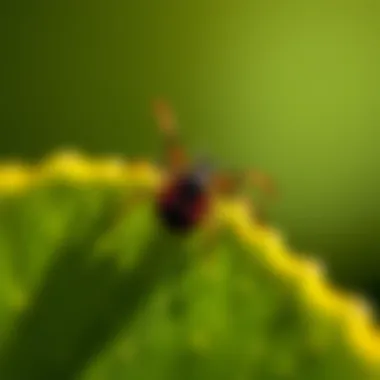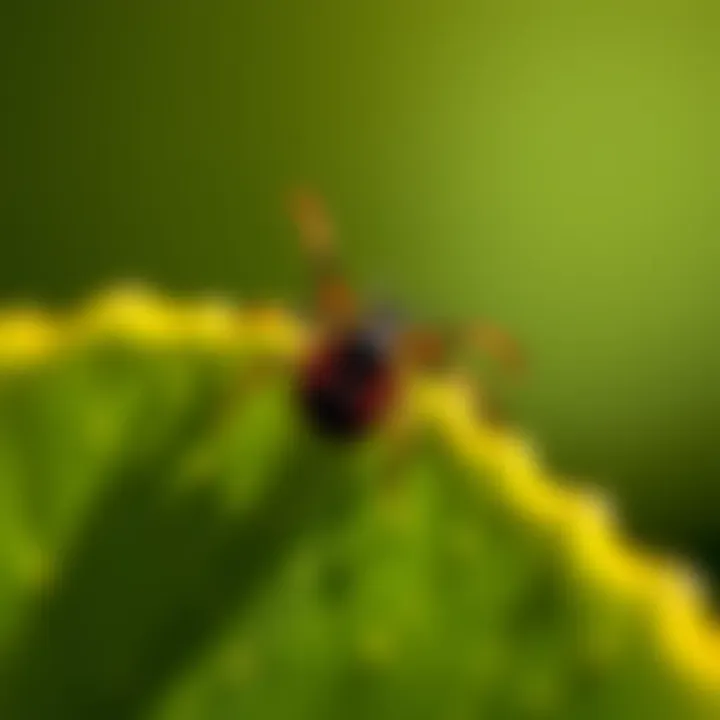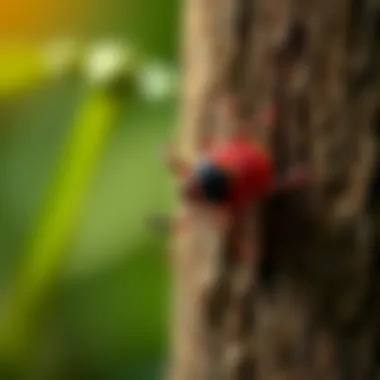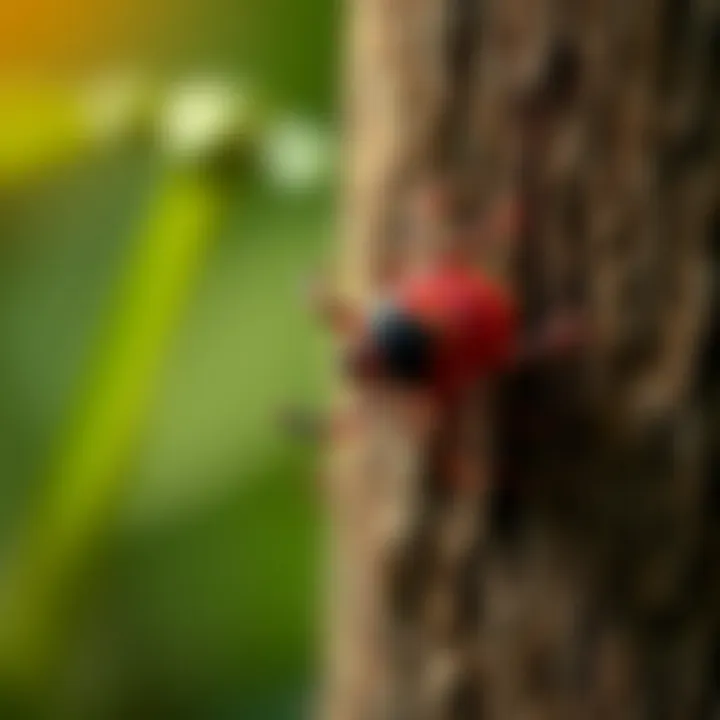Understanding Tick Habitats: Can They Live Indoors?


Intro
Ticks are small arachnids that can cause big problems for homeowners. Understanding their presence in our homes is crucial, especially for those with children, pets, or outdoor lifestyles. Many people wonder if these pesky little creatures can actually call their living spaces home. This article helps clarify the ins and outs of ticks, focusing on their biological traits, behaviors, and how they can invade our indoor environments.
Homeowners need to be aware of the specific tick species that may occur inside houses, the potential signs of an infestation, and most importantly, effective strategies for prevention and management. \nWhen you dig deeper into the life cycles of ticks, it becomes easier to understand how they thrive and the risks associated with their bites. Protected by a hard exoskeleton, they can latch onto unsuspecting hosts, sometimes carrying diseases that can impact human health. Let’s explore this topic to better arm ourselves against the lurking threat that ticks may pose in our homes.
Preamble to Ticks
Ticks are small yet undeniably significant creatures in the realm of public health and home safety. Understanding ticks is crucial, especially for homeowners who encounter these pests in various settings. By familiarizing oneself with ticks, their biological traits, habitats, and risky behaviors, one can not only protect themselves but also mitigate potential infestations. This section aims to shine a light on the role ticks play within our environments, deepening our appreciation for the intricate relationship between humans and these arachnids.
Definition and Classification
Ticks belong to the class Arachnida and are part of the order Ixodida. They are ectoparasites, primarily feeding on the blood of their hosts, which can range from mammals to birds, reptiles, and even amphibians. To set the stage for a more in-depth discussion about tick interactions within homes, it’s important to recognize that ticks are classified into two major families: Ixodidae, known as hard ticks, and Argasidae, or soft ticks.
- Ixodidae (Hard Ticks): Characterized by a scutum or shield-like plate that covers their back, these ticks are notorious for their ability to carry and transmit diseases.
- Argasidae (Soft Ticks): Differentiating features include a leathery and flexible body structure. These ticks feed primarily at night and are considered less dangerous in terms of disease transmission compared to hard ticks.
Understanding these classifications helps homeowners identify potential risks and recognize when tick management strategies need to be implemented.
Common Tick Species
While there are numerous tick species, some are more relevant to human encounters during outdoor activities or even within homes. Here are three common ones:
Black-legged Tick
The black-legged tick, often referred to as the deer tick, is known primarily for its role in transmitting Lyme disease. Its small size and dark color make it easily overlooked, which poses a risk to those who spend time in wooded or grassy areas. One notable feature is the bite of the black-legged tick; it typically requires a prolonged attachment to successfully transmit Lyme disease, which can lead to serious health issues if not promptly addressed.
Dog Tick
As its name suggests, the dog tick commonly feeds on canines but doesn’t shy away from humans. These ticks are larger and easier to spot, which can be a double-edged sword. While their bulk might make them easier to remove, the dog tick is a known carrier of Rocky Mountain spotted fever, presenting a significant health risk. What distinguishes the dog tick is its distinctive markings, which can help in identification, allowing homeowners to stay vigilant.
Lone Star Tick
The lone star tick is recognized for the distinctive white mark on its back, which can be an easy identifier. This tick has emerged prominently in recent years, partly due to its capability to transmit diseases such as anaplasmosis and ehrlichiosis. An interesting aspect of the lone star tick is its aggressive nature; it doesn't limit itself to animals as hosts, often opting for humans instead. This behavior makes it crucial for homeowners to be aware of their surroundings, especially in areas where these ticks are prevalent.
"Ticks are more than just nuisances; they are critical players in the ecosystem. However, their presence in homes raises questions about health safety and property management."
Being aware of these ticks and their habits helps homeowners better understand the risks they can present and underlines the importance of implementing effective prevention strategies.
Ticks: Biology and Behavior
Understanding a tick’s biology and behavior lays the groundwork for grasping how they may make their way into your home. The intricate details of their life cycle and feeding habits elucidate not just their survival strategies, but also how they interact with their environment, including indoor spaces. By familiarizing oneself with how ticks operate and thrive, homeowners are better equipped to prevent infestations and safeguard against the potential health threats these tiny creatures pose.
Life Cycle Stages of Ticks
Eggs
The life cycle of a tick begins with eggs that are laid in clusters in sheltered environments. This ensures that they are somewhat protected from predators and adverse weather. Each egg, although incredibly tiny, can hatch into a larva within a week or two, often contingent on temperature and humidity. A remarkable feature of tick eggs is their resilience; they can endure periods of desiccation. This means that even if conditions aren't ideal, some may survive long enough to hatch once it rains or becomes more humid.
- Key characteristic: The resilience of tick eggs contributes significantly to the survival of the species.
- Benefits: This resilience ensures the continuation of their life cycle despite short-term unfavorable conditions.
- Disadvantages: However, this can mean that ticks could re-emerge during humid periods, increasing risks for homeowners, particularly in climates that favor tick reproduction.
Larvae
After hatching, larvae are the next stage in the tick’s life cycle. These small, six-legged critters are often found in leaf litter or between blades of grass, waiting for a host to latch onto. The role of larvae is crucial as they must feed on blood to transition into the nymph stage, which typically occurs within several days following the first meal. One of their main characteristics is their ability to find hosts as they tend to be attracted to carbon dioxide, which mammals exhale.
- Key characteristic: Larvae can be so small that they are often overlooked, making them a silent risk factor.
- Benefits: Larvae's need for a blood meal helps explain how ticks may be inadvertently brought into homes by pets or even humans during outdoor activities.
- Disadvantages: Since they often go unnoticed, homeowners might not think to check themselves for ticks after being outside, allowing these pests to reach adulthood unnoticed.
Nymphs
Nymphs are the next stage where ticks gain additional legs, bringing a total of eight. At this stage, they become essential in spreading tick-borne diseases. Nymphs have a voracious appetite, and like their larval predecessors, they require a blood meal to survive and mature into adult ticks. Typically active during warmer months, nymphs tend to feed on smaller animals, however, they won’t hesitate to latch onto humans if the opportunity arises.
- Key characteristic: The increased risk of disease transmission is notable with nymphs, as they are the most active and are known to carry pathogens.
- Benefits: Understanding nymph behavior can help individuals take extra precautions during spring and summer, especially in known tick habitats.
- Disadvantages: The challenge lies in the fact that nymphs are often too small to be easily detected, which allows them to pose a higher risk to unwary homeowners.
Adults
The adult stage marks the end of a tick's life cycle and represents the largest risk for humans and pets. Adult ticks are often larger and easier to identify compared to larvae and nymphs. They can live for several months depending on environmental conditions and food availability. Female ticks typically engorge on blood before laying hundreds of eggs, thereby perpetuating the cycle. Their ability to survive for extended periods without feeding opens up the possibility for them to find their way into homes accidentally.
- Key characteristic: Adults can survive longer without food compared to their younger counterparts, providing adaptability in various conditions.
- Benefits: Their size and behavior make adults more recognizable, prompting more proactive measures amongst homeowners.
- Disadvantages: The presence of adult ticks in residential areas increases the chances of encountering tick-borne diseases, thus heightening the importance of pest prevention strategies.


Feeding Habits
Hosts and Blood Meals
Ticks rely on hosts for blood meals, which are essential at every stage of their lives—larvae, nymphs, and adults. While various animals serve as hosts, such as deer, raccoons, or even house pets, humans can become incidental hosts, especially in residential areas adjacent to wooded regions. The ability of ticks to detect their hosts through body odors, warmth, and carbon dioxide is quite remarkable; this sensory skill enables them to latch on effectively.
- Key characteristic: Ticks transmit diseases through their blood meals, which occurs when they are attached to a host for an extended period.
- Benefits: Understanding this can help homeowners better understand the conditions that allow ticks to thrive and reproduce near homes.
- Disadvantages: Misunderstanding how blood meals work can lead to lax preventative measures, putting individuals at risk of tick-borne illnesses.
Duration of Feeding
The duration for which a tick remains attached to its host can vary by species, life stage, and the individual tick itself. Generally, a tick can feed from several hours to days before completing its meal. This time frame acts as a critical window for disease transmission. If a tick feeds long enough, it can transfer pathogens to the host, often without immediate detection.
- Key characteristic: The length of time a tick is attached directly correlates with the risk of disease transmission.
- Benefits: Being aware of how quickly tick-borne diseases can be contracted emphasizes the need for timely tick checks after outdoor activities.
- Disadvantages: The stealthy nature of this feeding process can lead to undetected ticks staying attached long enough to pose serious health risks.
Ticks and Indoor Living Spaces
Understanding the dynamics of ticks within indoor living spaces is paramount for any homeowner. While these pests are often associated with outdoor environments, they have adapted to survive in various interior settings. Knowing where ticks might thrive indoors can be a significant advantage in preventing their encroachment into your home. The goal of this topic is to spotlight the potential indoor habitats and the environmental factors that could allow ticks to make your living spaces their own.
Possible Indoor Habitats
Basements
Basements often provide a cool, dark haven that many pests, including ticks, find appealing. The moisture accumulation in such areas makes them particularly inviting. A key characteristic of basements is their generally low human interference, which can allow ticks to flourish unnoticed. These hidden corners can hide not only boxes of old memories but also unwanted pests.
In terms of unique features, basements are typically more humid than other parts of the house due to potential leaks or lack of ventilation. This moist environment can especially benefit ticks, as they require certain humidity levels to survive and reproduce effectively. However, homeowners must be cautious; the absence of regular check-ups can lead to an unnoticed infestation.
Garages
Garages are another potential hotspot for ticks, often housing various items that facilitate their survival. A defining characteristic of garages is their often cluttered nature, providing plenty of hiding spots among tools, equipment, and seasonal items. This clutter can function as a perfect breeding ground for ticks.
Also, garages are frequently located near grassy or wooded areas, creating a direct pathway for ticks to enter. The unique feature here is that garages can vary widely in temperature and humidity, depending on how they are used. So, while they may be less ideal than basements for tick habitation in some respects, they can also provide warm, protected refuge for ticks, especially in fall or winter.
Attics
Attics, typically warmer and drier than other parts of a house, are often overlooked when it comes to pest control. Unlike basements, a unique aspect of attics is the potential for increased heat due to sunlight exposure, but they can also accumulate humidity due to poor ventilation. This balance of conditions can host a small, surviving tick population.
Ticks can be especially effective at hiding in the nooks and crannies of attics. One major disadvantage is the occasional presence of rodents attracting ticks, as rodents are often hosts to ticks. Homeowners should keep an eye on these spaces as they can easily become a hidden hotspot without regular inspections.
Factors Supporting Ticks Indoors
Humidity
A notable aspect of humidity is its direct effect on ticks’ survival rates. Ticks require a certain level of humidity to thrive. Indoor environments that are damp and humid provide a conducive atmosphere for ticks.
High humidity levels can make it difficult for ticks to desiccate, effectively allowing them to remain active longer inside homes. This vital characteristic should not be overlooked, especially for homes located in humid regions, as it clearly indicates a high risk for indoor tick prevalence.
Temperature
Temperature is another vital factor in the indoor survival of ticks. Ticks tend to favor environments that are neither too hot nor too cold. A stable indoor climate—especially warmth—supports their development and longevity.
Essentially, if a home is kept at a steady warm temperature, it becomes prime real estate for ticks. Both thermoregulation and moisture management will play a key role in lowering the likelihood of an infestation.
Presence of Hosts
The presence of hosts such as pets or even humans is fundamental for ticks’ survival indoors. A key characteristic of the presence of hosts is the provision of blood meals necessary for ticks’ reproduction. Without these hosts, ticks would struggle to survive and multiply as they rely heavily on the availability of a food source.
This unique factor means that homes with pets have a higher potential tick risk as those animals might bring ticks inside or provide an accessible meal. Understanding this relationship can lead homeowners to make informed decisions about preventive measures
"Keeping the areas where pets roam and sleep clean and treated by professionals can drastically reduce your home’s vulnerability to ticks."
By grasping these indoor habitats and supporting factors, homeowners can take proactive steps to mitigate the risks posed by ticks and maintain a safe living space. Through awareness and preventive measures, ticks can be kept at bay.
Risks Associated with Ticks in Homes
Understanding the risks that ticks pose within residential settings is essential for any homeowner aiming to protect their family. Ticks are not just creepy crawlers; they can transmit serious diseases, leading to complicated health issues down the line. Knowing what these threats are gives us the insights needed to take preventative measures.
In this section, we will explore health conditions that result from tick bites and the often-overlooked economic consequences of having these pests around.


Health Risks: Tick-borne Diseases
Ticks can carry a handful of diseases that vary in severity. These illnesses can wreak havoc if not properly addressed. Here are some of the significant diseases associated with tick bites.
Lyme Disease
Lyme disease stands out as one of the most common tick-borne illnesses. It is primarily caused by the Borrelia burgdorferi bacterium transmitted through the bite of an infected black-legged tick. One specific aspect of Lyme disease is that it can present flu-like symptoms early on, often fooling people into dismissing them as minor ailments.
A key characteristic of Lyme disease is its potential to develop into long-term health issues if left untreated. This makes Lyme disease an essential topic in our discussion, as our knowledge of it can lead to earlier detection and treatment. One unique feature of this disease is the characteristic "bull's-eye" rash that can appear at the bite site. However, not all individuals exhibit this telltale sign, which can make diagnosis tricky. Therefore, understanding Lyme disease is crucial for proactive home health management.
Anaplasmosis
Anaplasmosis is another tick-borne illness you should regard seriously. It arises from a bacterium called Anaplasma phagocytophilum, usually spread by the same black-legged tick that carries Lyme disease. The specific aspect of Anaplasmosis is how quickly it can lead to severe illness, especially in individuals with weakened immune systems.
What makes Anaplasmosis particularly noteworthy is its rapid onset of symptoms like fever, chills, and muscle aches, which can easily be mistaken for other conditions. This urgency highlights why homeowners must be aware of it. Unlike Lyme disease, Anaplasmosis can sometimes lead to complications, such as respiratory failure or even organ damage in severe cases. Therefore, recognizing the symptoms and seeking timely treatment is essential for reducing potential health risks.
Rocky Mountain Spotted Fever
Next up, we have Rocky Mountain Spotted Fever, caused by the Rickettsia rickettsii bacterium that infects ticks. This disease is primarily spread through the bite of an infected dog tick. Understanding the characteristics of Rocky Mountain Spotted Fever is vital since it has a higher mortality rate when not treated promptly.
The unique feature here is the presence of a rash that appears a few days after the onset of symptoms. This rash often starts on the wrists and ankles, distinguishing it from other tick-related disorders. The severity of this disease necessitates immediate attention. Ignoring symptoms can lead to severe complications, including cardiovascular issues or neurological damage. Hence, grasping what Rocky Mountain Spotted Fever entails highlights the importance of being vigilant.
Economic Consequences
The issues posed by ticks go beyond health; they also have economic implications. Homeowners cannot afford to turn a blind eye.
Medical Costs
When a tick-borne illness strikes, medical costs can skyrocket. The specific aspect of medical costs is the treatment needed for various illnesses, from Lyme disease to Anaplasmosis. Homeowners should be aware that these treatments often include multiple doctor visits, lab tests, and sometimes even hospitalization.
These costs can quickly accumulate, burdening families financially. Understanding the scope of these expenses emphasizes the importance of prevention strategies in managing household costs associated with tick infestations. Moreover, some insurances might not cover all tick-related medical expenses, pushing patients to pay out-of-pocket. This makes the topic not just a health concern but a financial one as well.
Property Damage
Another often ignored element is the potential for property damage caused by ticks. This may sound bizarre, but if tick populations become rampant, homeowners may need to invest in pest control solutions, landscaping changes, and other measures to limit tick presence.
The unique feature of property damage in this sense lies within the potential costs associated with professional pest control services. When an infestation occurs, it’s often not a one-time fix. Regular treatments may be necessary, leading to ongoing expenses that will empty a pocketbook faster than expected.
Prevention Strategies Against Ticks
Ticks may pose significant threats to health and well-being. Understanding and implementing effective prevention strategies can considerably mitigate these risks, especially for those living in areas where ticks are prevalent. This section outlines various tactics that can be employed to keep ticks at bay in and around the home.
Home Maintenance Practices
Landscaping Considerations
One key strategy in preventing ticks is maintaining your landscape. The way you design and care for your yard impacts tick populations significantly. A well-kept yard minimizes areas where ticks can thrive. Key characteristics of effective landscaping include keeping grass short and managing dense vegetation.
- Why It Matters: By reducing tall grass and excessive shrubbery, you effectively decrease the habitat that ticks prefer.
- Advantages: An aesthetically pleasing yard is not just better for appearances, but also lowers the risk of ticks. Planting tick-repellent plants, such as rosemary or lavender, can naturally deter them as well.
- Unique Features: On the flip side, ornamental areas that are overgrown can invite not only ticks but other pests too. Being mindful of landscaping choices helps in creating a barrier that protects your family and pets.
Seal Entry Points
Addressing your home's structural integrity plays a role in tick prevention. Sealing potential entry points, whether it's gaps in windows, holes around plumbing, or cracks in walls, serves as a basic yet powerful measure. This is good practice, mainly if you are situated in tick-heavy areas.
- Why It's Important: Ticks hitch rides on animals that come close to your home, including pets and wild animals. By sealing these openings, you can limit their access.
- Advantages: Not only does sealing entry points protect against ticks, but it can also reduce other pests like rodents and insects.
- Unique Features: While sealing may require a little time and effort initially, the peace of mind that comes from knowing ticks are less likely to invade is worth it.
Indoor Clutter Management
An often-overlooked aspect of prevention is how both indoor and outdoor clutter can support tick survival. Managing clutter, particularly in garages or storage areas, is vital.
- Key Characteristic: Clutter provides hiding places for ticks. Piles of laundry, unused equipment, or stacks of boxes create an inviting environment for ticks to linger.
- Why It’s Beneficial: Keeping indoor spaces tidy doesn’t just help you stay organized; it directly impacts the likelihood of tick populations in your home.
- Unique Features: While tidying up might feel like a mundane chore, the long-term benefits for health and safety make this a worthwhile endeavor.
Personal Protective Measures
Clothing Choices
When venturing outdoors, especially in areas where ticks are abundant, choosing the right clothing can be an effective barrier. Wearing long sleeves and pants that are tightly woven reduces skin exposure, making it harder for ticks to latch on.
- Why This Matters: Adopting appropriate clothing habits when engaging in outdoor activities minimizes the chances of tick bites substantially.
- Advantages: Light-colored clothing enhances visibility for ticks, making it easier to spot any that have attached themselves.
- Unique Features: Specialized clothing treated with repellents can provide additional layers of protection, though it tends to be pricier than regular attire.
Use of Repellents
In conjunction with suitable clothing, employing tick repellents can serve as an additional layer of protection. Applying insect repellents that contain DEET to exposed skin can help keep ticks at bay.
- Why It’s Essential: Utilizing repellents reduces the chances of tick bites, especially in high-infestation areas like wooded or grassy locations.
- Advantages: Many sprays repel not just ticks but other insects as well, providing broader protection.
- Unique Feature: However, it is crucial to follow label instructions carefully and consider skin sensitivities before use. Overuse may lead to unintended skin reactions.
Keeping your environment safe from ticks involves systematic approaches and a keen eye for detail. From proper landscaping to dressing wisely when stepping outside, implementing prevention measures can vastly reduce tick encounters.


Overall, awareness and proactive actions can create a safer living space, greatly reducing the possibility of ticks becoming unwelcome guests in your home.
Management and Treatment Options
Managing ticks in and around your home involves several methods, each aimed at minimizing their presence and preventing potential health risks. It is crucial to recognize that, while some ticks may wander indoors, proactive management can help keep them at bay. This section delves into the various techniques available for effective tick management and treatment options.
Physical Removal Techniques
Proper Tick Removal
Proper tick removal is a cornerstone of addressing tick infestations. Getting rid of ticks the right way helps prevent disease transmission to humans and pets. The key characteristic of this method is its focus on immediate removal when ticks are discovered. Whether on your skin or your pet’s fur, swift action is crucial.
A popular choice highlighted in this article is the use of fine-tipped tweezers for removal. Grabbing the tick as close to the skin’s surface as possible minimizes the risk of leaving mouth parts embedded. The unique feature of this method is its simplicity and reliability, making it accessible to nearly anyone. Though it requires steadiness and care, the advantages far outweigh the disadvantages — particularly, it’s non-invasive and doesn’t involve chemicals that might be harmful to the body.
Disposal Methods
The manner in which removed ticks are disposed is equally significant. Proper disposal methods ensure that ticks do not find their way back into your space or pose a future risk. The distinguishing element here is the requirement for safe disposal that reduces any chance of re-infestation.
An effective strategy includes placing ticks in a sealed bag or container, which can then be disposed of in the trash. Alternatively, some recommend flushing ticks down the toilet, although this method is less commonly recommended due to the risk of contamination. One unique feature of proper disposal is its potential to halt the life cycle of ticks and curb their populations nearby, supporting overall pest management. The downside may be the discomfort some feel when dealing with live ticks, which could deter prompt action.
Chemical Treatments
Insecticides
Insecticides stand as a formidable line of defense against ticks. These chemical agents work to reduce tick populations significantly. A key characteristic of insecticides is their ability to target adult ticks and in some cases, their eggs. This factor is vital in preventing a tick resurgence within your living environment.
Using insecticides in outdoor spaces, such as yards, can create a protective barrier against ticks. Unique features of these products often include specialized formulations targeting specific types of pests. However, it's essential to be cautious. While effective, insecticides can have adverse effects on non-target organisms like bees and other beneficial insects. Their use requires adherence to safety guidelines to mitigate any risks to humans, pets, or plants.
Natural Repellents
Natural repellents have gained traction among homeowners looking for eco-friendly alternatives to chemical treatments. The primary advantage of these products is their lower toxicity, aligning with a growing preference for natural living. These repellents often contain essential oils like citronella, eucalyptus, or neem oil that deter ticks effectively.
The unique feature here is that many natural repellents are safe for use around children and pets, making them attractive for family households. They also tend to have pleasant scents compared to traditional insecticides. However, one drawback could be their relatively shorter duration of effectiveness, requiring more frequent application compared to their chemical counterparts.
Professional Pest Control Solutions
When to Seek Help
If your tick problem escalates beyond manageable levels, it might be time to consider seeking help from professionals. A key aspect of determining when to seek assistance is recognizing a threshold of infestation that may be beyond DIY capabilities. If you’ve attempted various removal strategies and haven’t seen a change, it’s helpful to understand that professional pest control can provide specialized tools and expertise.
A major benefit of engaging professionals is their access to advanced treatments and thorough inspections which can uncover hidden tick populations in your home’s nooks. On the flip side, bringing in professionals can come with a higher financial cost, so it’s critical to assess the situation carefully.
Choosing a Pest Control Service
Selecting the right pest control service is pivotal in effectively managing ticks in your home. The key characteristic of a good service is their reputation and proven methods for tick management. It’s wise to research and look for services that offer integrated pest management (IPM) solutions, which focus on combining various control methods for longer-lasting results.
A unique feature includes checking for licensed pest control professionals who understand the specifics of local tick species and their behaviors. Moreover, reading reviews and obtaining referrals can provide insight into the effectiveness of pest solutions offered. However, one disadvantage might be the time and effort needed to find a reliable service, especially in areas with many options.
When managing ticks, an informed approach combining physical techniques, chemical applications, and, when necessary, professional help can significantly reduce risks associated with tick infestations in your space.
Closure: Understanding and Managing Ticks
The discussion around ticks and their potential to inhabit indoor spaces is of utmost significance. As we navigate through days spent in and out of our homes, awareness of these parasites becomes key. Ticks are not just nuisances; they carry diseases that can impact the health of your family. Understanding where they live and how they operate allows homeowners to act with foresight, ensuring their living environment remains safe. The previous sections have shed light on essential topics, including tick biology, habitats, and effective prevention methods.
Key elements to consider include the habits of ticks as they relate to human homes, the dangers of tick-borne diseases, and practical steps to mitigate infestations. For instance, maintaining your yard with appropriate landscaping choices can deter ticks from setting up residence near your property. Sealing gaps in your home and managing indoor clutter are simple yet effective ways to cut down on potential indoor tick habitat.
Homeowners have a critical role in this ongoing battle against ticks. By staying informed and proactive, one can reduce the risk of tick encounters and ensure a healthier living space. It's not just about identifying ticks; it’s about recognizing their impact and taking steps to protect loved ones from the consequences of their presence.
"An ounce of prevention is worth a pound of cure"—this old adage holds true with ticks. By implementing thorough prevention strategies, the likelihood of a tick encounter reduces significantly.
Summarizing Key Points
It’s essential to recap the vital insights from this exploration:
- Ticks can and do inhabit indoor spaces, particularly in areas like basements, attics, and garages.
- Environmental factors, including humidity and available hosts, contribute to their survival inside homes.
- They pose serious health risks, leading to conditions such as Lyme disease and Rocky Mountain spotted fever, which can affect the entire household.
- Preventive measures such as effective home maintenance, choosing the right clothing outdoors, and using repellents are crucial in limiting ticks.
- In case of infestation, knowledge of removal methods and when to seek professional help is imperative.
By synthesizing these points, homeowners can form a clearer understanding and prepare adequately against ticks. A proactive approach can lead to safer, healthier living conditions.
Future Perspectives on Tick Research
Looking forward, tick research is at a pivotal juncture. As populations of ticks evolve and spread to new regions, the implications for public health are richer than ever. Studies are increasingly focusing on understanding tick behavior, the mechanics of tick-borne diseases, and the ecological factors influencing tick distributions.
New technologies are anticipated to revolutionize how we manage ticks. Genetic studies could unveil the complexities of ticks' interactions with hosts, while advances in pest control techniques may offer innovative solutions to keep ticks at bay. Moreover, community awareness programs can help citizens understand the importance of tick prevention strategies as well as engage them in monitoring tick populations.
As we gather more data and refine our approaches, the role of interdisciplinary research, including veterinary science, environmental biology, and public health, becomes increasingly relevant. Education on ticks and their management will pave the path for healthier communities, free from the dangers they bring.



